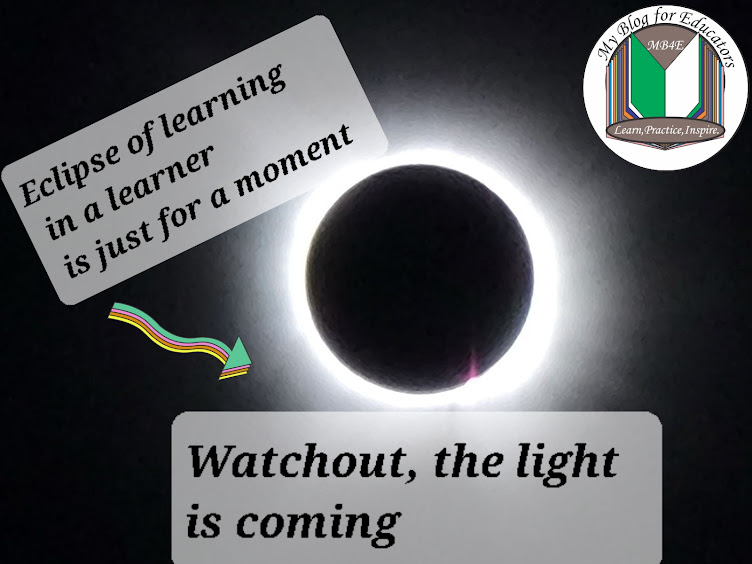In our last session on student engagement, we talked
about engaging learners with activities. Not just activities but ones that can
inspire, challenge and open a channel of curiosity to boost the learners' thinking
skills.
Before we delve into the active learning activities,
let us re-visit our perception of who our students are or should be.
As business persons, we know who customers are and who
partners are too. With customer's perception, we view relationships basically
from the money perspective-consumer, buyer, and shopper. Once the exchange of
good and services are received, we are done. Everything is to support sales and
boost services. Though most business persons go the extra mile to identify, satisfy
and retain their customers. The interest is largely in boosting sales and
services. Yes, no doubt value is added but to a limited level.
From the partnership perspective, the relationship with
learners is different. We view it from the investment and ownership angle. To
teachers, educators and educational institutions, learners are not just
customers but important members of the educational system. In fact, they are
the primary reason school is created. They should intentionally be involved in
the learning process and carefully handled. My question is, do we see our
learners; as customers or partners in learning?
Learners should be seen as partners in learning rather
than customers. This is because as partners, they will operate on a wider horizon of who they are and what they can do without limitation. As partners, they feel
a sense of ownership and can challenge the status quo by deeper thinking, positive
contribution and problem-solving. With a learning partnership mindset, learners
are ready to engage
I encourage teachers, educators and the school system
to see our learners through the lens of a learning partnership, not customers. This is because proper student engagement
begins with who our students are to us.
They are beyond 'Customers'.Come let us add more
meaning to our student engagement.
Watch the video below for more insight.👇👇👇
In our last session on student engagement, we talked
about engaging learners with activities. Not just activities but ones that can
inspire, challenge and open a channel of curiosity to boost their thinking
skill.
Before we delve into the active learning activities,
let us re-visit our perception of who our students are or should be.
As business persons, we know who customers are and who
partners are too. With customer's perception, we view relationships basically
from the money perspective-consumer, buyer, and shopper. Once the exchange of
good and services are received, we are done. Everything is to support sales and
boost services. Though most business persons go the extra mile to identify, satisfy
and retain their customers. The interest is largely in boosting sales and
services. Yes, no doubt value is added but to a limited level.
From the partnership perspective, the relationship with
learners is different. We view it from the investment and ownership angle. To
teachers, educators and educational institutions, learners are not just
customers but important members of the educational system. In fact, they are
the primary reason school is created. They should intentionally be involved in
the learning process and carefully handled. My question is, do we see our
learners; as customers or partners in learning?
Learners should be seen as partners in learning rather
than customers. This is because as partners, they will operate on a wider horizon of who they are and what they can do without limitation. As partners, they feel
a sense of ownership and can challenge the status quo by deeper thinking, positive
contribution and problem-solving. With a learning partnership mindset, learners
are ready to engage
I encourage teachers, educators and the school system
to see our learners through the lens of a learning partnership, not customers. This is because proper student engagement
begins with who our students are to us.
They are beyond 'Customers'.Come let us add more
meaning to our student engagement.
Watch the video below for more insight.
CUSTOMERS OR PARTNERS IN
LEARNING? Which are your learners?
In our last session on student engagement, we talked
about engaging learners with activities. Not just activities but ones that can
inspire, challenge and open a channel of curiosity to boost their thinking
skill.
Before we delve into the active learning activities,
let us re-visit our perception of who our students are or should be.
As business persons, we know who customers are and who
partners are too. With customer's perception, we view relationships basically
from the money perspective-consumer, buyer, and shopper. Once the exchange of
good and services are received, we are done. Everything is to support sales and
boost services. Though most business persons go the extra mile to identify, satisfy
and retain their customers. The interest is largely in boosting sales and
services. Yes, no doubt value is added but to a limited level.
From the partnership perspective, the relationship with
learners is different. We view it from the investment and ownership angle. To
teachers, educators and educational institutions, learners are not just
customers but important members of the educational system. In fact, they are
the primary reason school is created. They should intentionally be involved in
the learning process and carefully handled. My question is, do we see our
learners; as customers or partners in learning?
Learners should be seen as partners in learning rather
than customers. This is because as partners, they will operate on a wider-horizon
of who they are and what they can do without limitation. As partners, they feel
a sense of ownership and can challenge the status quo by deeper thinking, positive
contribution and problem-solving. With a learning partnership mindset, learners
are ready to engage
I encourage teachers, educators and the school system
to see our learners through the lens of learning partnership not customers. This is because proper student engagement
begins with who our students are to us.
They are beyond 'Customers' .Come let us add more
meaning to our student engagement.
Watch the video below for more insight.




